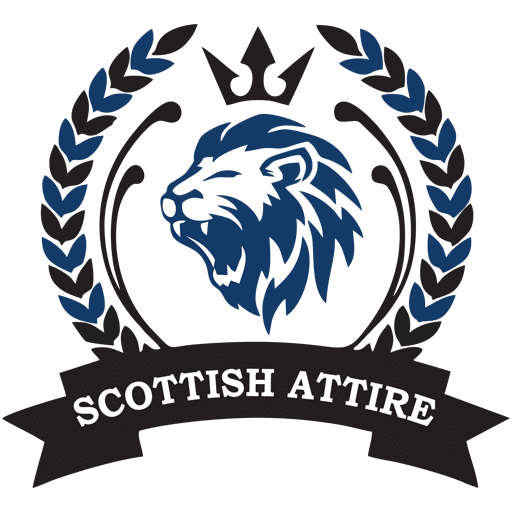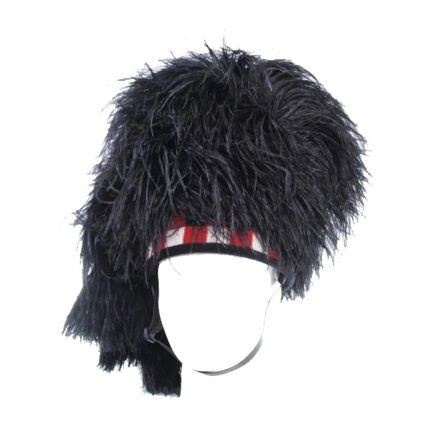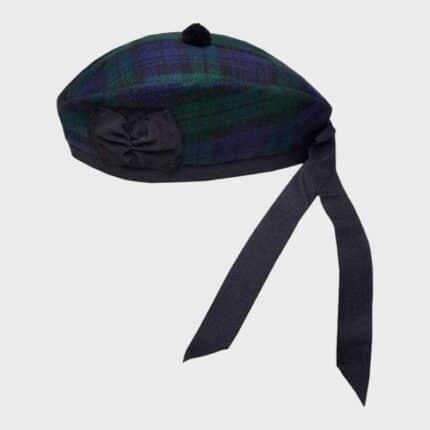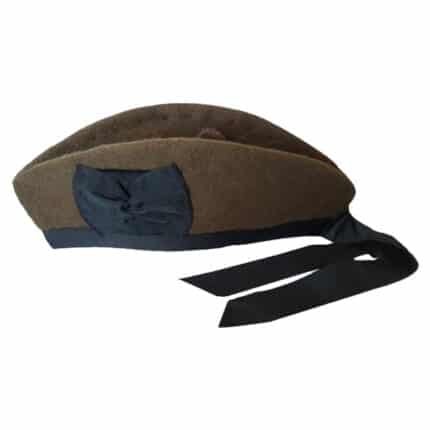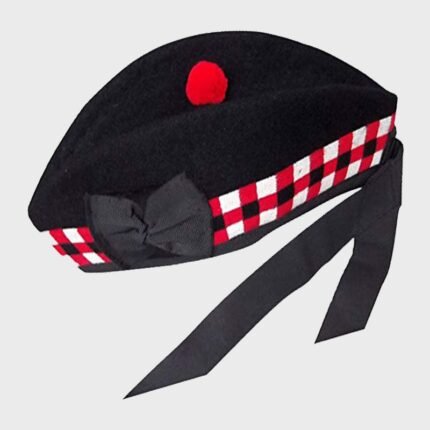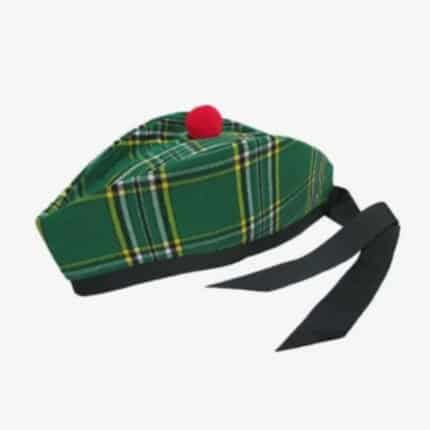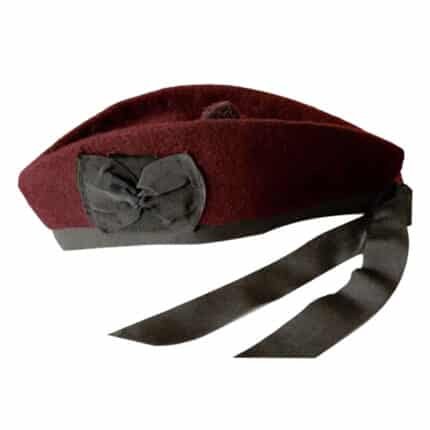Is a Balmoral Also a Type of Scottish Hat?

Indeed, a Balmoral is regarded as a particular kind of hat. The Balmoral is a Scottish hat that can be worn with formal or informal Highland attire. It is sometimes referred to as the Balmoral bonnet or Balmoral cap. Compared to the Glengarry cap, it is bigger and baggier. It is made of soft wool and is knitted. The crown is flat. It is sometimes woven from fine tartan, much like the Tam O’Shanter, and has a matching band with a toorie (pom-pom) on one side of the head, resembling a beret in certain aspects. Pipe bands and Army Cadets frequently wear the Balmoral as part of their uniforms.
Bunnet Is a Scottish Term of Hats
In Scotland, hats are called “bunnet.” The French word “bonnet” and the English word “bonnet” have similar etymologies. The term “bunnet” in Scotland refers to various hat, including the golf cap, the Glengarry bonnet, and the Balmoral cap. Interestingly, “bonnet” in this context usually refers to a men’s flat, brimless hat that highlights the diverse array of Scottish hat customs.
Historical background of the Balmoral Hat
The Balmoral bonnet, which originated from the 16th-century bluebonnet and is often referred to as the Kilmarnock bonnet or Balmoral cap, has a long Scottish history. This classic headgear has a flat crown and a soft, knitted wool cap; how it differs from the bluebonnet needs to be clarified. In the middle of the eighteenth century, it looked almost exactly like a black cap that Lord George Murray was wearing. Afterwards, in the late 19th century, the name “Balmoral” was created.
Initially worn by laborers, it became more and more well-known and eventually came to represent kilt dress. The British Royal Family frequently visits Balmoral Castle in Aberdeen shire, which bears the same name as the headgear. It is still beloved as a part of Scottish culture today and comes in various hues and designs.
Design of The Balmoral Hat
Throughout its history, the Balmoral hat’s design has changed. It began as a loose-crowned, soft-knitted hat with a snug band traced back to the 16th-century blue bonnet tradition. The term “Balmoral” was first used in the late 1800s. A version with a strengthened crown was briefly adopted by a few Lowland battalions in 1903. The Scottish Black Watch (Royal Highland Regiment) adopted the softer blue Balmoral as full-dress headgear after World War II. It has developed into a more structured and adaptable headdress throughout time, and you can now get it in a variety of hues and patterns in addition to the Glengarry hat.
Difference Between Balmoral Hat and The Tam O’Shanter?
The Balmoral and the Tam O’Shanter are very different in a few ways. Although both are classic Scottish hats, the Balmoral is better suited for dressier events due to its rounded top and superior doeskin in shades of grey or pale tan. It is also often woven with a distinctive diced hatband or a matching tartan band. The Tam O’Shanter, on the other hand, has a larger, flatter top that was initially hand-knitted in a single piece, stretched on a wooden disc to give it its distinctive flat shape, and then felted.
Therefore, what sets them apart are the shapes of the tops, the materials they are made of, and the events they work best for; the Balmoral has a more sophisticated style, while the Tam O’Shanter has a more homey feel.
What sets apart a beret from a Balmoral?
A Balmoral and a beret can be distinguished from one another by their distinctive features. Military personnel frequently wear berets because they are affordable to make, come in various colors, are easy to roll up and store, and can even hold headphones. In contrast, the Balmoral, a quintessential Scottish hat, has a rich historical background, having evolved from the bluebonnet and given its name in the late 1800s.
Wearable as part of official and informal kilt clothing, it is culturally important and linked to Canadian highland troops, ploughmen, carters, and the humbler ranks. It stands out due to its unique gross-grain ribbon and cockade.
Can I Wear Balmoral hat at Occasions?
The ageless charm of the Balmoral hat, a symbol of Scottish tradition, lends itself to many occasions. This classic Scottish bonnet has a place, whether you’re attending formal events or enjoying the carefree vibe of casual Highland attire. Its adaptability is shown in how well it works for formal occasions—such as marching in Celtic festivals or parades as a clan representative—and casual get-togethers when the spirit of Scottish culture is honored. This flat-crowned, soft knit wool cap, named after the famous Balmoral Castle, is a timeless piece of fashion jewelry for people who value the marriage of history and modernity.
The Material Use To Make Balmoral Hat at Scottish Attire?
The Scottish Attire’s Balmoral hat is well known for its outstanding quality and classic appeal. The finest pure acrylic tartan is used to craft each Balmoral hat, which is then masterfully knitted and milled to produce an opulent felted texture. This traditional headpiece perfectly embodies Scottish heritage with a charming pompom on top and sophisticated ribbons flowing down the back.
Are the Scottish Hats available at Scottish Attire in various sizes?
With pride, Scottish attire provides a broad assortment of hats and caps that are painstakingly crafted to accommodate many tastes and requirements. Our selection features a vibrant color scheme, genuine tartans, and unique styles. We currently have outstanding types and styles in stock: the timeless Balmoral Cap and the refined Glengarry Bonnets. These magnificent Scottish hats come in sizes ranging from 56 to 62 cm, so everyone can find their optimum fit and comfortably and stylishly embrace Scotland’s heritage. We take great pride in providing our customers with the best possible fit.
Can I find hats with clan-specific Tartan patterns at Scottish Attire’s Website.
Scottish attire is happy to present a wide assortment of headwear featuring tartan designs unique to individual clans. With more than 1400 distinctive Scottish tartans in our collection, you will surely find the ideal cap to display your Scottish ancestry proudly. Whether you’re looking for a classic Scottish cap or something more modern, we have the ideal hat to highlight the unique tartan of your clan. Discover the perfect accessory to show Scottish patriotism by browsing our wide selection.
See Our Hat Shop
Bagpiper Synthetic Feather Bonnet
Original price was: $339.00.$299.00Current price is: $299.00.Black Watch Glengarry Hat
Original price was: $31.00.$21.00Current price is: $21.00.Black Watch Tam o Shanter Hat
Original price was: $41.00.$31.00Current price is: $31.00.Brown Glengarry Hat With Pom
Original price was: $31.00.$21.00Current price is: $21.00.Camel Of Thompson Tartan Tam o Shanter Hat
Original price was: $41.00.$31.00Current price is: $31.00.Glengarry Bagpipe Hat
Original price was: $31.00.$21.00Current price is: $21.00.Glengarry Hat Feather Hackle
Original price was: $31.00.$21.00Current price is: $21.00.Irish National Glengarry Hat
Original price was: $31.00.$21.00Current price is: $21.00.Maroon Glengarry Hat
Original price was: $31.00.$21.00Current price is: $21.00.

